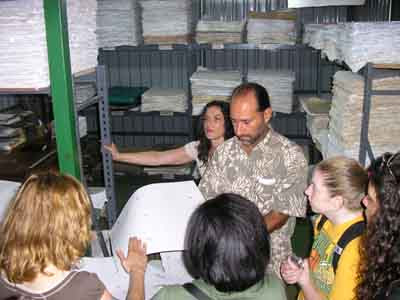The Start of the Making Paper: Old Paper
The company buys pre-consumer and some post-consumer waste white paper (seen here in the brown paper wrapped package). This paper is roughly chopped up and placed in buckets of water with bacteria to prevent molding (bottom right). The paper soaks in the water for 3 weeks after which the paper bits are put in a blender and ground up into a pulp (the long soaking makes this process easier). The plant fibers are then added the pulp is moved to the forming basins. The whole soaking and grinding process depletes the fibers that made the original paper sturdy which is why more fibers, in this case from natural sources, must be added after blending by which time most of the fiber destruction has occured. The more water goes into this mixture, the thinner the paper will be.
Pressing Paper by Hand & Mechanically
After the paper drip dries next to the basin, it is flipped off its screen onto an absorbant fabric (in this case a thin synthetic wool). Water is manually squeezed out with a cup made from bamboo (shown top left). The screen is then removed and another sheet of fabric placed ontop of the paper. This process is repeated until a large stack is formed. The stack is then un-stacked and reformed making sure every sheet of paper is completely flat and adding a sheet of metal under each piece of paper. The new stack is then placed in a press where more water is mechanically squeezed out (shown bottom right).
Warehouses & Sample Paper
Molinos Tierra Verde or Artesanías Finas del Pueblo specializes in recycled paper products made with natural, Costa Rican fibers. The six most used fibers are grass, corn, pineapple, banana, fern, and coffee. Other fibers, mostly agricultural by-products, are collected from local farmers markets and farms and include cabuya, melon, and pine-needles. Most paper produced is anywhere from 10 to 80% fiber with high fiber counts resulting in grainier and more rustic-looking papers that can be used for covers. The plant also produces some 100% fiber paper to be used for decorative binding covers. Also, if fiber is cooked before being added to the paper pulp, a much thinner and smoother paper can be produced. A sample of several different fiber counts and fiber types is shown above (center, bottom). After the paper is produced, the paper products are made at the plant in the on-site warehouse and cutting shed (shown above, left). Here large sheets of paper are cut to size, bound, and printed. Once production is complete, finished and packaged goods are kept in an off-site warehouse where visiting students and store-owners can purchase goods (shown above, right).

Drying Paper
After mechanical squeezing, the paper is unstacked and each sheet of paper, on its sheet of metal, is placed on a shelf inside a drying oven (shown above). At this plant, the oven is heated using scrap wood from around the farm and from other local farms. Due to inefficiencies in design, the oven here only reaches a temperature of about 45°C at which temperature the paper must be dried for about 3 hours. Also, the paper must be rotated through the oven during these three hours since some parts of the oven dry faster than others. In a more efficient oven, temperatures of about 80°C would dry the paper in about 10 minutes. After drying, paper is sorted by quality and weight: high, medium, and low, and very thin, semi-thin, and thick. Very thin paper is compressed and flattened one final time in a paper press for a few hours before being cut, decorated, and bound, and otherwise finished for sale.
Newly Made Paper
Once the paper pulp and fiber mix is moved in the forming basins. Basins can be any size or shape but for a comercial plant should be large with straight sides and a large enough mouth to easily fit a screen of the desired size. The screen is used to pull an even layer of pulp and fiber out of the water-pulp-fiber mixture in the basin. The screen is pushed into the mixture in the basin and then lifted out, always keeping it as horizontal as possible, and then set on a rack to the side of basin to drip dry (shown here) while the next screen is lowered into the mixture. The screen used here is made from mosquito netting and nylon ornamental sunscreen stretched over a metal frame.

María Giovanna Huarado
María Giovanna Huarado (shown here, center, talking to two EEI students) started working with Molinos Tierra Verde four years ago as an administrator of sorts. She manages paper marketing and output as well as helping with development of new products. Currently the market for natural paper is down due to the high number of producers for a limited and almost completely international (as opposed to local) market. María is working to increase quality to minimize profit losses as well as seeking out venders so they can sell paper more directly. The company also makes products to special order and is working on a line of greeting cards with their recycled paper, but lined with re-used paper for easier writing, to sell in the Costa Rican market. María hopes that Ticos will buy their new products despite the lack of flashy Western modernity before other companies start copying their idea. This lack of time is an issue for all of the companies products as paper “factories” cannot copyright their ideas either in method of paper production or in design of products (binding of notebooks, style of photo album, or greeting cards lined with re-used paper).
Author: Sami Nichols






















































